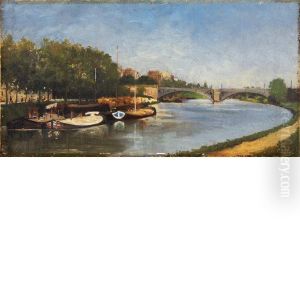Stanilas Lepine Paintings
Stanislas Lépine was a French artist, born in 1835 in Caen, Normandy. He is most recognized for his contributions to the Impressionist movement, although he never gained the same level of fame as some of his contemporaries. Lépine's early life was steeped in the picturesque landscapes of Normandy, which would later influence his choice of subjects in his artistic career. He moved to Paris to pursue his art education, where he studied under Jean-Baptiste Camille Corot, a leading figure in the Barbizon school of France, which emphasized painting nature in a direct, plein air manner that prefigured Impressionism.
Lépine's work is characterized by its subtle use of light and delicate treatment of the urban and rural landscapes, often featuring the Seine River, the bridges of Paris, and scenes of the Normandy coast. His palette was typically restrained, favoring muted tones that evoked a serene, contemplative mood. Despite his undeniable skill and the quality of his work, Lépine struggled to achieve recognition during his lifetime. He exhibited at the Paris Salon, the official art exhibition of the Académie des Beaux-Arts in Paris, and was also a participant in the first Impressionist exhibition in 1874, which was a pivotal moment in the history of modern art. However, his contributions were often overshadowed by the more prominent members of the Impressionist movement.
Lépine's dedication to capturing the ephemeral effects of light and atmosphere on the landscape aligned him with the Impressionist ethos, though he maintained a more traditional approach to composition and technique. His works, while not as widely known or celebrated as those of his peers like Claude Monet or Camille Pissarro, provide a valuable insight into the evolution of landscape painting in the late 19th century. Stanislas Lépine passed away in 1892 in Paris, leaving behind a body of work that has since gained greater appreciation for its quiet beauty and refined execution. Today, his paintings can be found in several major museums, where they are celebrated for their contribution to the Impressionist movement and their unique portrayal of France's urban and rural landscapes.
